Silicates: Zircon
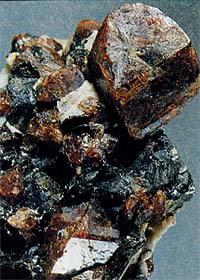 Diagnostic card.
Diagnostic card.
Two samples of zircon: the crystalline habit of this mineral is clearly visible in the form of a short prism square in cross section.
Zr SiO 4
Tsingonia tetragonal
Hardness 6,5-7,5
Specific weight of 4.55-4.67
Cleavage unclear
Cracked shell
Color is colorless, differently colored
Color in powder white
Shine from glass to semi-diamond

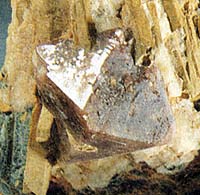 Zircon is known since ancient times. Its name was derived from the Persian zargun - a golden stone. High light refraction and strong dispersion cause a bright game, close to the diamond. The mineral is very fragile and requires caution when cutting. A significant admixture of radioactive elements (U, Th) is the reason for the fluctuation of physical properties.
Zircon is known since ancient times. Its name was derived from the Persian zargun - a golden stone. High light refraction and strong dispersion cause a bright game, close to the diamond. The mineral is very fragile and requires caution when cutting. A significant admixture of radioactive elements (U, Th) is the reason for the fluctuation of physical properties.
Green zircons under the influence of the radioactive elements contained in them sometimes undergo significant changes and structural disturbances, so that they become almost amorphous (metamictic).
Hyacinth - a yellowish-red or reddish-brown variety of zircon. Starlit is a blue variety, obtained artificially by roasting.
Brown zircon of different shades, sometimes white, colorless, rarely red, green, yellow, black. Zircon contains uranium and thorium - elements of the radioactive group, capable of emitting alpha particles. The decay of radioactive elements causes damage to the crystal lattice in this gem. For this reason, it is necessary to distinguish full-value zircons with an intact crystal lattice from those whose lattice is damaged by bombardment with radioactive particles.
Full-value zircons are referred to as "high type", while the other group (its representatives are usually opaque or translucent) refers to the "low type". The first, usually transparent, orange-brown, pinkish, greenish, blue or colorless, are used as jewelry stones.
Crystals of zircon have a short-prismatic habit; Endings are often crowned with facets of bipyramids. More rarely, the crystals can be elongated or composed only of bipyramids. A typical shine is from glass to semi-diamond. Zircons are distinguished by an unclear cleavage, a conchoidal fracture and increased brittleness. The coloring of zircons (which they owe to radioactive and rare earth elements) is particularly sensitive to heat treatment, thanks to which it is possible to obtain the finest blue or golden zircons from pinkish-brown.
Chemical composition-content (in%): ZrO2- 67.1; SiO2-32.9; Common admixtures of hafnium (alvite), yttrium, cerium, phosphorus, niobium (nagite), tantalum, thorium, uranium (malacon, cyrtolite). Transparency - transparent (yellow transparent zircon - hyacinth), translucent, opaque. Singonia is a tetragonal, dipitragonal-dipyramidal form of symmetry. Cleavage is absent or imperfect in (110). It occurs in the form of well-faceted sharp-pointed crystals of long-prismatic and dipiramidal habit. The main simple forms are: (110), (100), (112), (101), (211) and (331). Twins are observed in accordance with (101), rarely in (111) and (211). Sometimes cranked and cross-shaped, sheath-like and radial-radiate coalescence are developed. Dimensions of crystals are usually small (several millimeters), large zircons are considered to be larger than 1 cm.
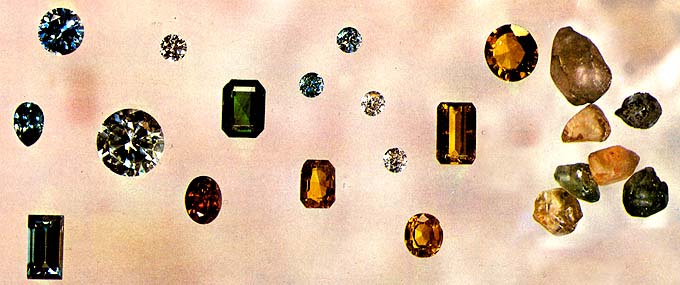
Diagnostic signs.
Some zircons are photosensitive. They lose color in the light and are able to restore it, if they are again placed in the dark. In nature, greyish-and reddish-brown zircons are most often encountered; Colorless stones are very rare. In countries of South-East Asia, by calcining brownish varieties at 800-1000 ° C, colorless and blue zircons are obtained. The color that has arisen during roasting is not always stable. Ultraviolet or sunlight can cause it to discolor. Similar to zircon are minerals such as aquamarine, cassiterite, chrysoberyl, hessonite, sapphire, singualite, synthetic spinel.
Origin.
Zircons are common minerals of igneous rocks, especially granite rocks and metamorphic rocks formed due to them. Crystals of small size are formed in pegmatites. The main deposits of jewelery quality stones are placer deposits.
Place of Birth.
Industrial deposits of jewelry stones are found in alluvial gravels of Sri Lanka, Burma and Thailand. Beautiful specimens of zircon are also found in Australia, the Urals and Norway. Zircon deposits (mostly placer deposits) are found in Kampuchea, Burma, Thailand, Sri Lanka, as well as in Australia, Brazil, Madagascar, Tanzania, Vietnam and France (Upper Loire).
Use in jewelry.
As jewelry stones, transparent, beautifully colored zircons are used. The share of jewelry zircons is a small percentage of the total volume of their production. Zircons, with the exception of colorless, are processed exclusively in the form of an oval or rotunda of mixed or brilliant cut, modified by the addition of facets, mainly in the tent. The demand for zircons and their cost are not stable, the popularity of hyacinths is constant. Colorless zircons are usually attached to a diamond, and color - graded cut. Synthetic zircons are of interest only for scientific purposes. Green zircons, rare in the market of jewelry stones, are very much appreciated by collectors.

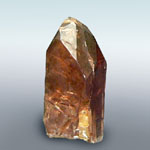
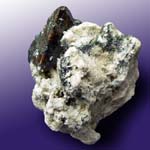
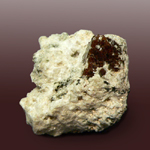

Zircon. Rounded grains from kimberlites. Russia. Photo: © А.А. Evseev.
ADR 1

The bomb that explodes
They can be characterized by a number of properties and effects, such as: critical mass; Scatter of fragments; Intensive fire / heat flow; bright flash; Loud noise or smoke.
Sensitivity to shocks and / or impacts and / or heat
Use the shelter, while keeping a safe distance from windows
Orange sign, the image of a bomb in the explosion
ADR 4.1

Highly flammable solids , self-reactive substances and solid desensitized explosives
Risk of fire. Flammable or combustible substances can ignite from sparks or flames. May contain self-reactive substances capable of exothermic decomposition in the case of heating, contact with other substances (such as: acids, heavy metal compounds or amines), friction or impact.
This can lead to the emission of harmful or flammable gases or vapor or spontaneous combustion. Containers can explode when heated (over-dangerous - practically do not burn).
Risk of explosion of desensitized explosives after loss of desensitizer
Seven vertical red stripes on a white background, equal in number, ADR number, black flame
ADR 4.2

Substances that are capable of self-ignition
Risk of fire due to autoignition in the event that the packaging is damaged or the source of the contents has occurred.
Can react violently with water
White upper half of diamond, red - lower, equal, ADR number, black flame
ADR 3


Highly flammable liquids
Risk of fire. Risk of explosion. Capacities can explode when heated (highly dangerous - easily burned)
Use shelter. Avoid low areas of the surface (pits, lowlands, trenches)
Red diamond, ADR number, black or white flame
ADR 5.1

Substances that are oxidized
Risk of violent reaction, ignition or explosion if exposed to flammable or flammable substances
Do not allow the formation of a mixture of cargo with flammable or combustible substances (eg sawdust)
Yellow diamond, ADR number, black flame above the circle
ADR 7


Radioactive materials ( radiation , Ukraine)
Risk of absorption of external and internal radiation exposure
Limit impact time, radiation burns, radiation exposure of photographic and cinematographic materials
Yellow upper half of rhombus, white - lower, equal, ADR number, black sign of radiation, inscription
ADR 8

Corrosive (corrosive) substances
Risk of burns from skin corrosion. They can react violently with each other (components), with water and other substances. The substance that spilled / crumbled can emit a corrosive vapor.
Dangerous to aquatic environment or sewer system
White upper half of diamond, black - lower, equal, ADR number, test tubes, hands
| The name of a cargo that is particularly dangerous for transportation | room
UN |
Class
ADR |
| ZIRCONIUM - POWDER HUMIDIFIED with a mass fraction of water not less than 25% | 1358 | 4.1 |
| ZIRCONIUM - POWDER Dry | 2008 | 4.2 |
| ZIRCONIUM DRY in the form of processed letters, staff or coils from wire in coils | 2009 | 4.2 |
| ZIRCONIUM DRY in the form of spirals made of wire, processed metal sheets, frogs (thinner than 254 microns, but not thinner than 18 microns) | 2858 | 4.1 |
| ZIRCONIUM, SUSPENSIONED IN FLAMMABLE LIQUID | 1308 | 3 |
| ZIRCONIUM, SUSPENSIONED IN A FLAMMABLE LIQUID (vapor pressure at 50 o C over 110 kPa) | 1308 | 3 |
| ZIRCONIUM, SUSPENSIONED IN FLAMMABLE LIQUID (vapor pressure at 50 o C not more than 110 kPa) | 1308 | 3 |
| ZIRCONIA Waste | 1932 | 4.2 |
| Zirconium Hydride | 1437 | 4.1 |
| Zirconium Nitrate | 2728 | 5.1. |
| ZIRCONIA PICRAMATE WASHED with a mass fraction of water not less than 20% | 1517 | 4.1 |
| ZIRCONIA PICRAMATE dry or moistened with a mass fraction of water less than 20% | 0236 | 1 |
| Zirconium tetrachloride | 2503 | 8 |
Poisonous and radioactive dangerous stones and minerals
** - poisonous stones and minerals (mandatory check in the chemical laboratory + explicit indication of toxicity)
** - radioactive stones and minerals (mandatory check on the standard dosimeter + ban on open sales in case of radioactivity exceeding 24 milli / g / h + additional measures of population protection)
Catalog of minerals and semi-precious stones of the world by groups
** - poisonous stones and minerals
** - radioactive stones and minerals


Comments
Commenting on, remember that the content and tone of your message can hurt the feelings of real people, show respect and tolerance to your interlocutors even if you do not share their opinion, your behavior in the conditions of freedom of expression and anonymity provided by the Internet, changes Not only virtual, but also the real world. All comments are hidden from the index, spam is controlled.